Speed reviewing, Nov. 2019 – part two
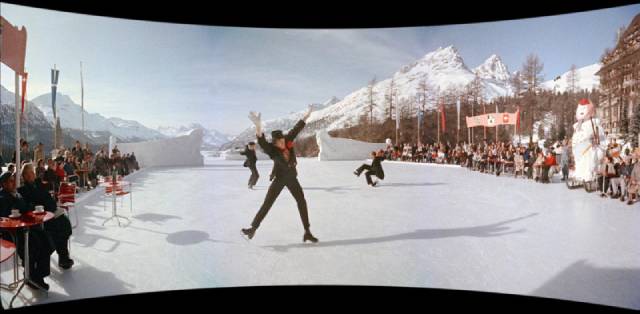
Cinerama Holiday
(Robert L. Bendick & Philippe De Lacy, 1955)
In the early 1950s, filled with dread by the rising popularity of television, the movie business tried to find ways to keep audiences interested in the theatrical experience. 3D flourished briefly, but the most lasting change was the use of a wide screen. The winner of that race ended up being Cinemascope and similar systems – using anamorphic lenses to squeeze and unsqueeze the image horizontally, or more simply just matting out the top and bottom of the 35mm frame. The most ambitious and cumbersome development was Cinerama, which used a huge system of synchronized cameras and projectors to link three separate strips of film to create an ultra wide image which was shown on a wraparound screen to give the impression of immersion in the picture. Like IMAX three decades later, Cinerama couldn’t quite escape being a gimmick. Its purpose was spectacle, and the few attempts to use it for drama weren’t very successful. Again, like IMAX, it was best suited for scenery, which is why so many productions were contrived travelogues.
Cinerama Holiday (1955) was the second big travelogue in the format, stringing together a random collection of sequences on the hook of two couples – one Swiss, one American – vacationing in each other’s countries. The Swiss couple cross the Southwestern desert on a motor scooter, visit Las Vegas, take in a show, then head for the coast. The Americans go skiing, watch the Ice Capades, and in the best example of the format’s possibilities, the husband goes on a bobsled run, which we get in one long uninterrupted POV shot. As with later IMAX “documentaries”, narration tends to be anodyne, offering nothing to interfere with the passive consumption of all the eye candy.
The randomness of the movie eventually leads to a bizarre turn in which we get to experience what it’s like to fly in a jet fighter taking off from and landing on an aircraft carrier.
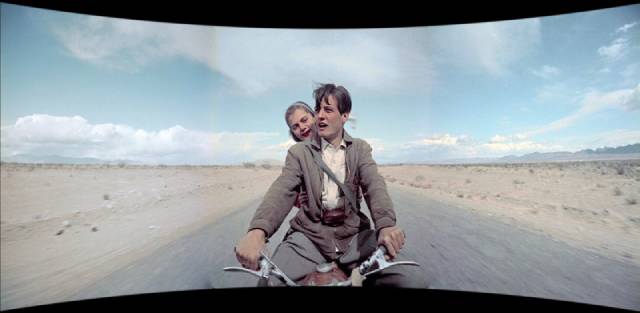
The Flicker Alley dual-format release is presented in “smilebox”, replicating the curved effect of the Cinerama screen. As is typical of Cinerama, the seams between the images are visible as a slightly discoloured vertical blur, and during pans there is quite a bit of distortion around the joins where the three panels don’t quite match up. There are a bunch of extras on the disk, including behind the scenes material and retrospective interviews with some of the cast.
*
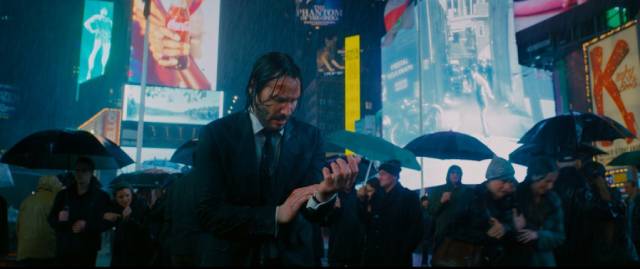
John Wick 3 (Chad Stahelski, 2019)
Not much to say about Keanu Reeves’ third time out as hitman John Wick. What began as a slick and implausible piece of action nonsense has devolved into absurdity – Wick and his enemies engage in elaborate combat in the middle of a busy train station with the public walking around them oblivious of the violence. Action which becomes so totally disconnected from any sense of material reality is so weightless that it’s impossible to give a damn about what’s going on. The Lionsgate Blu-ray is as slick as you’d expect, with a bunch of brief behind-the-scenes featurettes.
*
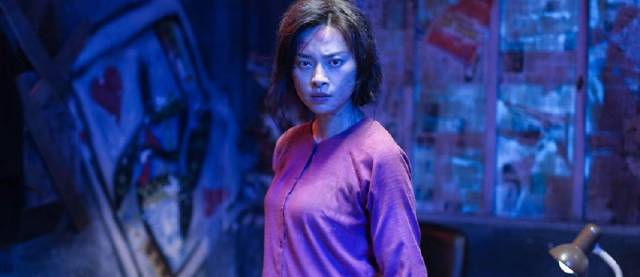
Furie (Le Van Kiet, 2019)
As if to prove my point about screen action, along comes this Vietnamese feature which loosely models itself on the Taken movies. Furie (2019) is about a woman with “a particular set of skills” whose daughter is kidnapped by a gang of organ traffickers. Hai Phuong (Veronica Ngo) survives by collecting debts for a loan shark in a small town. She’s held in contempt because of her work (which literally involves breaking people’s legs), but also because she’s an unwed single mother. That status and her job cause friction between her and daughter Mai (Mai Cat Vi) and they’ve just had an argument when the girl is taken … so apart from the urgency of the situation, Hai is racked with guilt as she sets out to track the gang.
There are a couple of things Furie has going for it, starting with that basic set-up which immediately invests everything that follows with emotional stakes. But most important is Veronica Ngo, who makes for a fantastic, driven heroine, punching and kicking her way through the Hanoi underworld against a very tight deadline. She has great screen presence and the kind of fighting skills and ability to take a beating that give Asian action movies such a visceral impact. There’s also the novelty of the Vietnamese setting, which is something I haven’t seen before in a modern context.
Furie is generic, but made with skill and energy, and given some heart by Ngo’s performance. The image on the Well Go Blu-ray looks fine and there’s a making-of featurette.
*
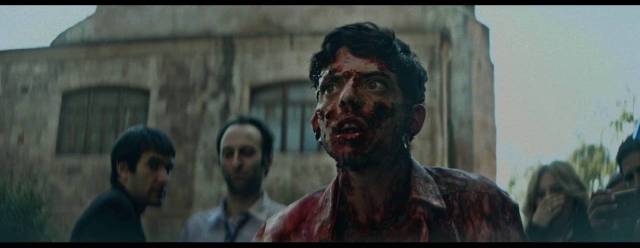
The Night of the Virgin (Roberto San Sebastian, 2018)
Not sure what to make of this Spanish horror-comedy. Nico (Javier Bodalo) is a twenty-year-old nerd who hopes to score at a New Year’s Eve party and lose his virginity. He can’t believe his luck when he attracts the attention of an older woman, Medea (Miriam Martin), who takes him back to her place. She gives off a weird vibe and her apartment is kind of creepy, decorated with pagan symbols. Nico is torn between being creeped out and wanting to get laid, and while he’s trying to decide what to do, Medea’s boyfriend starts banging on the door and demanding to be let in. Sexual anxiety rapidly escalates … and Nico discovers that Medea is an ageless supernatural being who needs him to impregnate her to continue her race (she needs a virgin for this, which is why her boyfriend can’t do the deed). The night gets progressively more icky and violent, and things don’t end well for Nico.
The biggest problem with the movie is that Bodalo makes for such an unappealing protagonist that it’s impossible to care about his plight. San Sebastian is more interested in gross-outs than engagement in the story. The MVD Visual DVD is appropriately grungy.
*
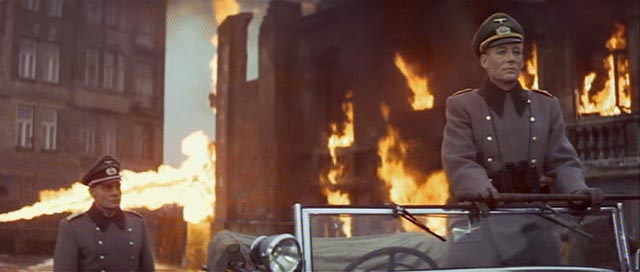
The Night of the Generals (Anatol Litvak, 1967)
I watched Anatol Litvak’s The Night of the Generals (1967) again recently because I replaced my Twilight Time Blu-ray with Eureka’s edition – and I did that because Eureka has added an informative commentary from author Scott Harrison. Despite its flaws, I’ve always liked this mix of crime film and war movie, and I enjoyed seeing it again with a slightly improved image.
*
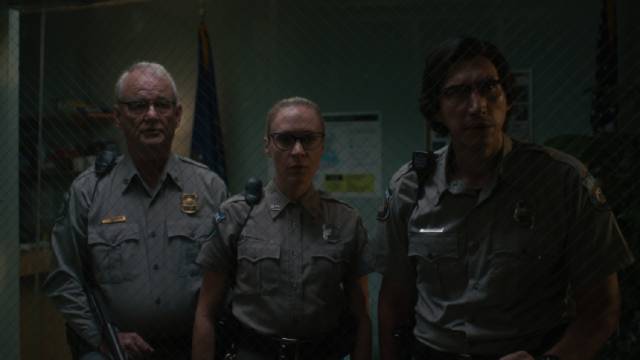
in Jim Jarmusch’s The Dead Don’t Die (2019)
The Dead Don’t Die (Jim Jarmusch, 2019)
Jim Jarmusch has been a favourite since I first saw Stranger Than Paradise (1984) more than thirty years ago. His low key, laconic, deeply ironic style isn’t for all tastes, but over three decades he’s provided a refreshing antidote to a mainstream too much given to bombast and overstatement. While it’s fair to say his work has been uneven, he’s created several masterpieces, which is a lot more than you can say for quite a few higher profile filmmakers – Paradise, Down by Law (1986), Broken Flowers (2005), Ghost Dog (1999), and particularly Dead Man (1995). Six years ago, he unexpectedly turned to a genre which seemed at odds with his usual observational social comedy; Only Lovers Left Alive (2013) was a melancholy vampire tale which, along with the previous year’s Byzantium (Neil Jordan, 2012), made a valiant attempt to rescue that genre from the then-current insufferable teen romance of the Twilight movies.
Less well received has been Jarmusch’s most recent feature, which tackles another popular horror trope, the zombie. Perhaps it’s because zombies lack the potential thematic and emotional range of vampires, but The Dead Don’t Die (2019) remains more at the level of pastiche rather than an exploration of fully-formed characters via a pop culture phenomenon. It has a kind of throwaway attitude, a filmmaker and his friends playing at horror for their own amusement. But that said, I found myself pleasurably sharing their amusement. This tale of a small town and its police force dealing with a zombie apocalypse brought on by climate disaster is packed with Jarmuschian dead pan humour pitched just right by a great cast – Bill Murray, Adam Driver, Chloe Sevigny, Tom Waits and a whole crowd of supporting players. While the movie is ultimately pretty weightless, it’s still an engaging entertainment with occasional genuinely moving grace notes. It also looks terrific thanks to the great cinematographer Fred Elmes.
*
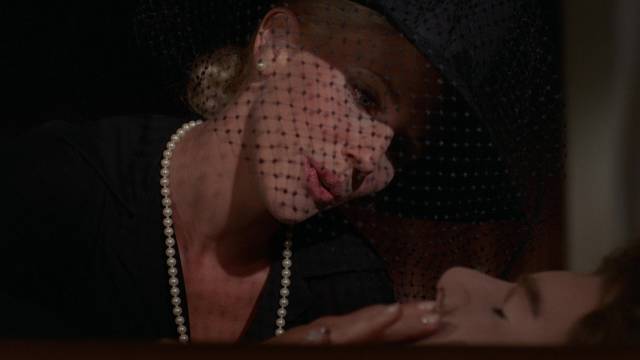
Love Me Deadly (Jacques Lacerte, 1972)
Necrophilia has always been a tricky theme for movies, yet filmmakers have been repeatedly drawn to it, going back at least as far as Edgar G. Ulmer’s The Black Cat (1934). Most famously, there’s Jorg Buttgereit’s pair of poetic gross-out experimental features, Nekromantik 1 and 2 (1987/1991), and Joe D’Amato’s Beyond the Darkness (1979). In the mid-’90s, Canadian filmmaker Lynne Stopkewich made a stir with her debut feature, Kissed (1996), which starred Molly Parker as a woman who can only find sexual satisfaction in the morgue. While on its surface, it appears that this is mostly about the ultimate objectification of one’s sexual partner, the literal reduction of a lover to a slab of meat, it has been attracting the morbidly romantic for centuries – there are hints in fairy tales like Sleeping Beauty, it runs through Poe’s stories and poems – but it looks like an intractable subject for mainstream movie-making.
Yet here’s an oddity from the early ’70s, a necrophile feature co-starring Lyle Waggoner, best known for his long service on the Carol Burnett Show – in fact, he appeared in this midway through that tenure, which must have made for some strange conversations backstage! It also marked the second big screen appearance by Christopher Stone, nine years before Joe Dante’s The Howling (1981). Love Me Deadly (1972) was the sole credit of writer-director Jacques Lacerte, and it apparently got a theatrical release in the U.S., Canada and Italy (according to IMDb), though I assume it had more life (pardon the pun) on home video.
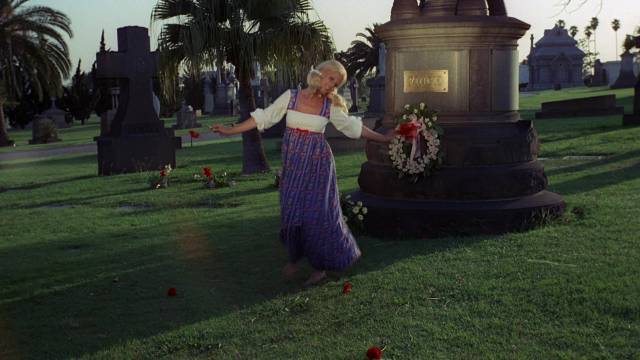
It’s hard to tell what audience it was aimed at. It’s pitched as a “case study” the same way Ed Wood’s Glen or Glenda (1953) was. Here, an apparently respectable middle class woman named Lindsay Finch (Mary Wilcox) can’t bear to be touched by men, but sneaks into funerals to try and steal a kiss from the corpses displayed in their open caskets. (This has something to do with unresolved Daddy issues.) While she’s pursued by sensitive businessman Alex Martin (Waggoner), she’s also targeted by mortician Fred McSweeney (Timothy Scott), who recognizes her illicit desires at one funeral. Alex marries her, only to be rejected from their shared bed, while Fred lets her know she’s not alone – in fact, he runs a little group which regularly gets together in the funeral home’s back room to have fun with the latest arrivals. And if business is slow, Fred is not above creating a fresh corpse for their orgy … which doesn’t bode well for Alex when he begins to investigate Lindsay’s secret life.
Apart from the transgressive subject, which seems even creepier in sunny Southern California locations, the movie has a surprising amount of quite explicit nudity. You begin to get the uncomfortable feeling that for Lacerte, as for Ed Wood, this is more than a calculated commercial venture – it seems more like a personal confession of the filmmaker’s own socially problematic desires. It’s even more disturbing to hear that Lacerte was a high school drama teacher! Code Red’s Blu-ray has a surprisingly strong image (a “2K scan of the original camera negatives”) and provides some valuable exploitation history through a commentary from producer Buck Edwards (recorded for a 2008 Shriek Show DVD).
*
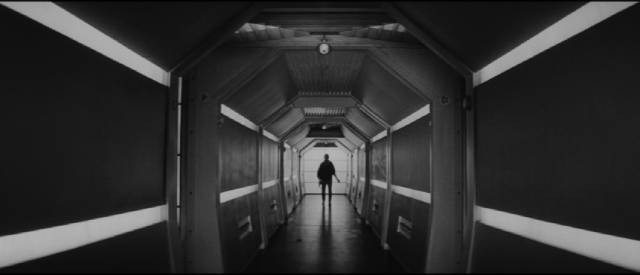
Ikarie XB 1 (Jindrich Polak, 1963)
Despite the weight of Socialist Realism hanging over the Eastern Bloc during the long reign of Stalin, the East like the West had an interest in science fiction and stories of space travel. More often than not there was a theme of spreading the values of the Revolution beyond the bounds of Earth … from Jakov Protazanov’s Aelita: Queen of Mars (1924) through Vasily Zhuravlyov’s Cosmic Journey (1936) to Kurt Maetzig’s The Silent Star (1960). The technology displayed in many of these movies was more impressive than a lot of their Hollywood counterparts, not least in Jindrich Polak’s Czech epic Ikarie XB 1 (1963), based (without credit) on an early story by Stanislaw Lem (whose work has been adapted frequently, from The Silent Star through Tarkovsky’s Solaris [1972] to His Master’s Voice [2018]).
Ikarie XB 1 depicts the first interstellar space voyage, with an on-board community of men and women of multiple nationalities – a model for Star Trek a few years later. The crew meet various dangers familiar from sci-fi movies of the period, like a derelict ship (pointedly representing the decadent West and armed with nuclear weapons which reactivate when disturbed) and a nearby black hole which produces madness-inducing radiation sickness. But mostly, the film is concerned with such prosaic details as eating, exercising, partying and even the birth of the first baby in space as the ship progresses on its fifteen year voyage (which will be much longer back on Earth due to time distortion caused by near-light speeds). This aspect, not to mention set and costume design, no doubt influenced elements of Stanley Kubrick’s 2001: A Space Odyssey (1968) and Douglas Trumbull’s Silent Running (1972).
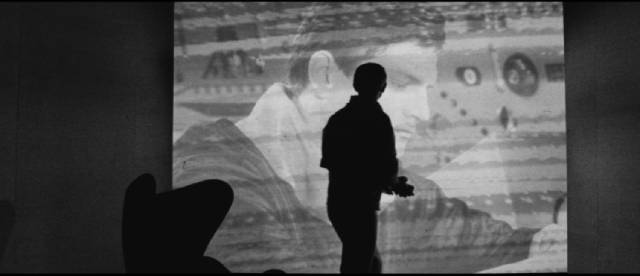
Picked up by AIP, given the title Voyage to the End of the Universe, and subjected to bad dubbing and a “twist” ending which paved the way for many surprise revelations to come, Ikarie XB 1 at least remained relatively intact for North American audiences – unlike other Eastern Bloc sci-fi movies which were often ransacked for their superior special effects, while their stories were discarded. In its original form and in a new 4K restoration on Second Run’s Blu-ray, it stands as a significant and influential part of genre film history. Extras include an introduction by Kim Newman, who situates it in that history, a short documentary (also 1963) about mathematicians and their contributions to computing and space travel, and a lengthy essay about the film by Michael Brooke.
Comments
We just watched The Dead Don’t Die at Friday Night Movie night and I enjoyed it. I liked his vampire movie too. I was more excited to watch the 2015 Canadian film Turbo Kid. Delightful gore effects and a nice sense of humor in general. I saw it and then ordered the Blu-ray/DVD 3 disc set.
I love Turbo Kid. Bought it on spec when it first came out. They managed to make an affectionate parody of ’80s post-apocalyptic movies which works both as a commentary on those movies and as a great example of the genre in itself.
And don’t forget the sexy robot.
I watched it for the ideas!